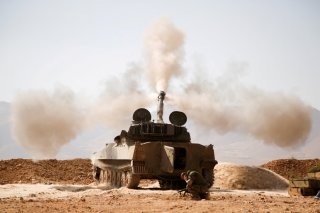From Civil To Proxy War: How Syria Became Iran And Israel's Battlefield
By one count, there have been over 150 Israeli strikes in Syria stretching all the way back to 2012.
Iran, Hezbollah and Russia Team Up to Save Assad
In 2011, the Arab Spring caused a wave of political unrest to sweep across the Middle East, igniting a civil war in a drought-stricken Syria. By 2012, the Damascus had lost control of vast swathes of the country to a disunited Sunni Arab and Kurdish rebel groups.
Tehran did everything it could to save Assad, dispatching teams of Iranian Revolutionary Guard Corps soldiers and officers to train and lead Syrian government troops into battle. However, the fragmenting Syrian military required more manpower as the rebellion spread—so in 2012, around 3,000 Hezbollah fighters poured over the Lebanese border to join the fight on behalf of Assad.
In truth, even the support of Iran and Hezbollah was not enough for Assad to win the war—but they kept his regime on life support. It was the intervention of Russian military and mercenary forces starting in the fall of 2015 that finally turned the tide.
Syria remained the last major outpost of Russian influence in the Middle East, notably in the form of a naval base at Latakia. Moscow calculated that not only would intervention in the war preserve Syria as an asset, but also afford it a chance to test numerous weapons system which had never been used in combat before, thereby advertising their capabilities to potential export clients.
Now that Assad’s hold on power is secure, it’s becoming clear that growing infrastructure of Iranian bases in Syria is likely there to stay—and that Iran intends to use them to funnel drones, artillery, anti-aircraft and anti-tank weapons to Hezbollah to challenge Israeli military dominance. This has elicited an intensifying Israeli bombardment campaign to knock out the buildup, both through preemptive strikes and reactive counterattacks.
So far, the exchange has been a lopsided one, with only a single Israeli warplane shot down by Syrian air defense over seven years, in exchange for dozens of targets hit by Israeli guided munitions and numerous facilities and advanced weapons destroyed. Iranian and Hezbollah forces, however, have continued to test Israeli defenses with drones and artillery, so the proxy war could potentially continue escalating for some time.
Sébastien Roblin holds a Master’s Degree in Conflict Resolution from Georgetown University and served as a university instructor for the Peace Corps in China. He has also worked in education, editing, and refugee resettlement in France and the United States. He currently writes on security and military history for War Is Boring. This article first appeared in 2018.
Image: Reuters.

